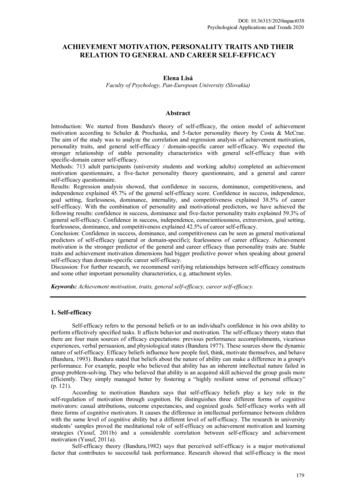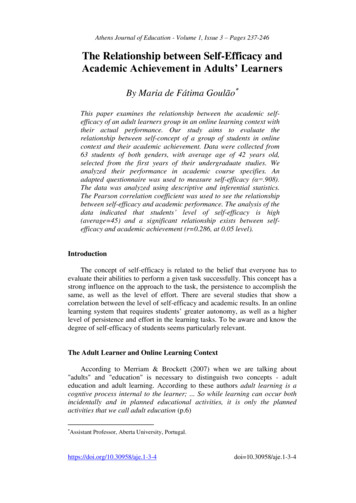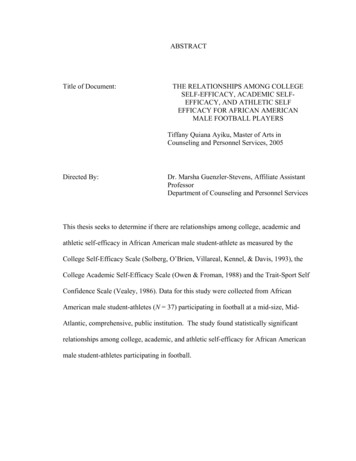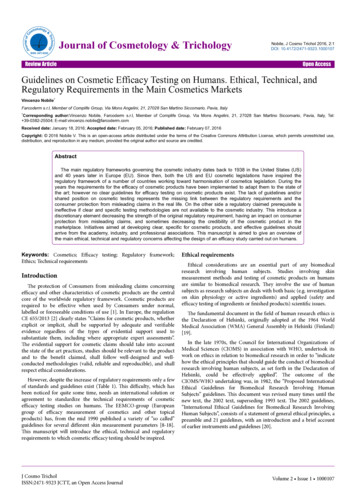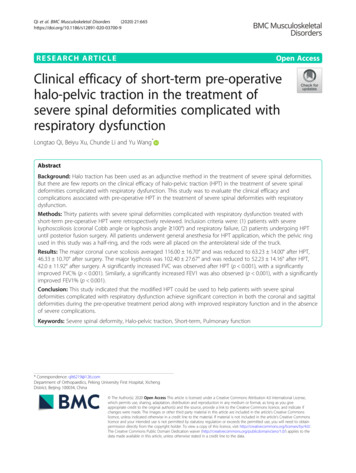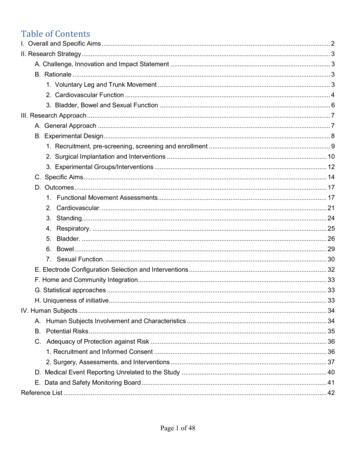
Transcription
Evaluation of the efficacy and mechanisms of a novel intervention for chronicpain tailored to people living with HIVSTUDY PROTOCOLVersion 1.0August, 2018Send Questions or Comments to:Alissa Eugeni ale64@pitt.eduJessie Merlin, PI merlinjs@upmc.edu
I.STUDY OVERVIEWBehavioral interventions for chronic pain among people living with HIV (PLWH) arean understudied area, with great potential to improve pain and function. Chronic painis an important comorbidity that affects between 30% and 85% of PLWH and isassociated with greater odds of functional impairment, increased emergency roomutilization, suboptimal retention in HIV care, and failure to achieve virologicsuppression. What is not known is how to optimally address chronic pain in thispopulation. Opioids are a commonly used treatment for chronic pain, particularly inPLWH. Opioid prescribing for chronic pain often does not result in substantialimprovement in outcomes and contributes to the growing epidemic of opioidaddiction and overdose. In contrast, behavioral interventions are among the mosteffective and safest treatments for chronic pain in the general population. Pain SelfManagement (PSM) is a Social Cognitive Theory (SCT)-based behavioral approachthat involves pain-related skill acquisition and goal setting. PSM interventions havebeen promoted by the 2016 Department of Health and Human Services NationalPain Strategy (DHHS NPS) as an effective, scalable approach to chronic painmanagement. Especially given the current opioid crisis, the DHHS NPS underscoredthe urgent need to develop and test PSM interventions tailored to the unique needsof vulnerable populations, particularly PLWH, that can be implemented anddisseminated nationwide. Until an effective and scalable PSM intervention for2
chronic pain in PLWH is developed, reducing the burden of chronic pain safely andeffectively in this population will not be possible.II.OBJECTIVESOur long-term goal is to significantly reduce the burden of chronic pain comorbidityin PLWH through the creation of an effective PSM intervention for HIV care settings.Our overall objective toward achieving that goal is to evaluate a novel theory-basedPSM intervention, “Skills TO Manage Pain” (STOMP), that we developed for PLWH.We conducted a 44-participant, 2-arm randomized pilot trial of STOMP vs. usualcare. Findings show that STOMP was feasible, acceptable, and showed preliminaryevidence of impact on pain and function. Additionally, final analysis of STOMP’scost/QALY was substantially lower than the 50,000 to 100,000/QALY benchmarkoften used to indicate cost-effectiveness. Although based on a pilot trial and,therefore, preliminary, these findings are promising, and suggest the importance ofcost analyses in future STOMP trials.For this study, we will accomplish our overall objective by focusing on the followingprimary specific aim: 1). Evaluate the efficacy of STOMP, a theory-basedintervention tailored to improving chronic pain in PLWH. Given the rigorousintervention development process and promising pilot trial results, our workinghypothesis is that STOMP will decrease pain severity and improve function inPLWH. We propose a two-arm randomized trial of STOMP vs. a usual carecomparison condition (N 280).3
We also propose the following secondary aims: 2). Conduct exploratory analyses ofthe impact of STOMP on HIV outcomes associated with chronic pain. Our workinghypothesis is that STOMP will not only decrease pain severity and improve function,but increase retention in HIV primary care and virologic suppression rates.3.Investigate proximal outcomes as potential mediators of STOMP’s impact on chronicpain. During our formative work, we incorporated the key SCT constructs of selfefficacy, outcome expectations, and self-regulation into the intervention. Our workinghypothesis is that these constructs are “proximal outcomes” through which theintervention’s impact on pain and function is mediated.This study will be conducted at the University of Alabama at Birmingham (UAB) andthe University of California at San Diego (UCSD), two sites within the (CNICS) cohort.The University of Pittsburgh will serve as the lead site and will provide training andoversight.III.STUDY ACTIVITIESa) STUDY POPULATIONA total of 280 participants who are patients at UAB and UCSD - enrolled in CNICS,experiencing chronic pain (Brief Chronic Pain Screening Questionnaire (BCPQ) atleast moderate pain for at least 3 months) and moderately severe and impairing chronicpain (PEG pain questionnaire average of all three times is 4 or greater).4
Inclusion Criteria1. Enrolled in CNICS2. Age 18 years3. English-speaking4. Chronic pain (Brief Chronic Pain Screening Questionnaire (BCPQ) at leastmoderate pain for at least 3 months)5. Moderately severe and impairing chronic pain (PEG pain questionnaire average of all three items is 4 or greater)6. Ability and willingness to attend the group sessions at the date/time specified7. No plans for major surgery during the study period that would interfere with studyprocedures.Exclusion Criteria1. Do not speak or understand English2. Are planning a new pain treatment like surgery3. Cannot attend the group sessions4. Had previously participated in the pilot study (STOMP)5. Unwilling to provide informed consentWe will rely heavily on active recruitment using patients identified as having chronic painon the BCPQ and PEG on CNICS pain Patient Reported Outcome measures.Additionally, participants will be recruited via word-of-mouth by clinic staff or providers,calls generated from flyer tear-offs and other advertisements placed in the clinic.5
b) PRE-SCREENING (phone and then in-person)Potential participants will be prescreened over the phone using our prescreening phonescript once the participating site. A HIPAA waiver will be submitted with the initialsubmission. If the individual passes the telephone prescreen, he or she will bescheduled for an in-person pre-screening visit by a member of the STOMP recruitmentteam. The date and time of the pre-screening visit along with the participant contactinformation and preferred method of contact will be recorded on the Prescreening VisitAppointment Form. Data from the pre-screening phone call and visit appointment formswill be transferred to a prescreening excel log for accurate tracking. About 48 hoursprior to the in-person prescreen visit, a reminder call from the research staff will bemade to remind the potential participant of the prescreening visit. If the research staffcannot locate the potential participant after three attempts, the staff will note an inactivestatus in the prescreening log.On the day of the prescreen, The research staff member conducting the prescreen willlog onto Redcap and establish a unique RedCap instance for this participant andcomplete the prescreen section only. Participants will be required to sign a prescreenconsent form before the initiation of the session. At the end of the prescreen, theresearch staff member will record the participant’s eligibility on the Prescreening VisitAppointment Form. If the participant is eligible for enrollment, a Screening andEnrollment Visit will be scheduled and recorded on a Screening and Enrollment Visitform. A separate excel log will collect data from the screening and enrollment visit formfor tracking purposes. The participant will also be thanked and given their 25 incentive.6
If the participant is not eligible, he or she will also be thanked for their time and given a 25 incentive.c) SCREENING AND ENROLLMENTThe Screening and Enrollment Visit will be scheduled approximately 2-4 weeks from thedate of the pre-screen visit and recorded on a Screening and Enrollment Visit form.Participants will receive a reminder call at about a week and 48 hours prior to thescheduled screening and enrollment visit. At the beginning of the screening andenrollment visit, the participant will complete the informed consent process, and thenthey will complete a baseline assessment.Informed Consent ProceduresInformed consent will be administered by staff trained in accordance to the University ofPittsburgh, the University of Alabama at Birmingham and the University of California atSan Diego’s Institutional Review Boards’ guidelines for obtaining informed consent. Thestaff member obtaining consent must verify the following: protocol name, versionnumber, dates for use, and institution. The Study team member will also ensure that themost recent informed consent is being used for the study. Initial informed consent mustbe completed and documented before any other study related procedures are done.Comprehension will be assessed by asking the participant to summarize the studyactivities or some general open ended questions will be asked like what can you tell meabout this study, can you tell me about how long the study may last, etc. The consentprocess is estimated to take around 30 minutes. Study staff will ensure that the7
participant has signed and dated the consent form including the HIPAA form. All signedconsent forms will be stored in locked file cabinets under respective participant files.Baseline AssessmentThe research staff will then administer the baseline assessment which includes aconfirmatory set of screening questions via RedCap. Confirmation of the participant’seligibility will be recorded in RedCap. If a participant is ineligible based on this RedCapassessment, they will be given a 50 incentive and thanked for their time, and they willnot be considered to have been enrolled in the study at any point (informed consent isasked before this point so that we can use any data generated in published findings). Ifa participant is eligible, they will also be thanked for coming and given their 50incentive payment for their time. Completion of Baseline assessment will be recorded inexcel logs.RANDOMIZATIONOur team will utilize a 1:1 ratio for allocation to the STOMP intervention and Usual Care(UC) conditions. Our study statistician, Dr. Long, will use SAS to generate therandomization scheme stratified by whether the participant is on long-term opioidtherapy (taking prescribed opioids for at least 3 months) and whether they have chronicmultisite pain (pain in at least 3 locations or pain all over). Importantly, the PIs andoutcomes assessors will be blinded to intervention vs. comparison allocation.Participants in the intervention and comparison conditions will have full access to allavailable clinical services at their respective sites.8
d) INTERVENTIONThe intervention group will receive “treatment as usual” plus the STOMP behavioralintervention. The “treatment as usual” refers to the standard of care that patientsreceive at the UAB and UCSD clinics. This standard of care is for patients to discusschronic pain with their providers at their discretion. Although highly variable, providerscan recommend and prescribe pharmacologic (e.g., opioid and other pain medication),non-pharmacologic (e.g., physical therapy, referral to psychology) approaches for pain.This study will not interfere in any way with usual care.The STOMP behavioral intervention consists of 12 intervention sessions (6 group and6 individual sessions). The sessions will be completed over a period of 12-16 weeksfrom enrollment. The first intervention session will be a group session for allparticipants followed by individual and then alternating group and individual sessionsfor the rest of the intervention. The intervention group will utilize a study manual onpain management in which they will use with each session.Group intervention SessionsA total of 6 group sessions will be conducted over a period of 12-16 weeks from studyenrollment date. These sessions will be led by a peer. A peer is an HIV-infected patientof the UAB or UCSD clinics living with chronic pain and is a successful self-manager ofhis/her chronic pain. Peers will receive training that will include being a participant in allone-on-one sessions, and additional training to co-facilitate the six group sessions with9
the interventionist. Prior to the beginning of the first group session, participants will signan Agreement of Confidentiality.Participants will receive a reminder call/text approximately 48 hours before the groupsession to remind them of the upcoming session. If the participants cannot be reachedon first contact, research staff will conduct up to three reminder calls or texts before thegroup session. Participants will also be notified of the upcoming group sessions at theend of each one-on-one intervention. Group sessions will be conducted in designatedclinics at UAB and UCSD. A sign-in sheet will be used to document attendance.Session notes will be used to document any major issues presented or any anecdotalnuances identified. The date, start time and end time of the session will also bedocumented. Participants will complete an anonymous session feedback form at theend of each session. Each session will be audio recorded and transcribed later using athird party.Individual Intervention SessionsA total of 6 individual sessions will be conducted over a period of 12-16 weeks fromstudy enrollment date.Each individual intervention session will be scheduled by the staff interventionistspreferably prior to next group session. The intervention date and time will be recordedon the Individual Intervention Session Form along with the intervention no. and topic.The participant will receive a reminder communication about the upcoming session10
approximately 48 hours before the session. An Intervention Session Form will be usedto record the date, time, length of session, topic covered, homework, next steps, andany nuances identified during the session. An adverse event form will be completed ifany physical, social or psychological issues arise a result of participating in this studyand warrant immediate attention. The date of the next group session will be announcedand the date of the next one-on-one session will be recorded at the bottom of theIntervention Session Form. Participants will complete a-session feedback form at theend of each session. Each session will be audio recorded. Selected sessions will bereviewed by a member of the research team not participating in the session for fidelityusing the fidelity checklist (see Fidelity, below).Reminder callsStudy staff will conduct up to 3 reminder calls to remind about their upcomingintervention session. Please note the purpose of these calls is to remind aboutappointments but in case patient initiates the conversation regarding intervention orother related to the study staff will talk to participant regarding intervention.We will implement a series of best practices if a participant misses a session. This willinclude contacting the participant within a day of the missed session to schedule amake-up session in-person or by phone depending on the participant’s preference;during that session, engaging in problem-solving as to why they missed the session andwhat barriers they envision going forward, and how those barriers might be addressed;and allowing participants to phone into group sessions if needed. If there are things we11
can do to help that are reasonable (e.g., more reminders, more transportationassistance, or other things), we will provide them. Additionally, if they miss more thanone visit, they may receive a call asking about their future participation in the study andwhether, if they are unwilling to participate in intervention sessions, they would bewilling to just complete outcome assessments.AssessmentsAll participants in the intervention group will also receive a REDCAP assessment atbaseline, post-intervention (0-month, after all sessions are completed), and then at 3, 6,9 and 12 months post-intervention. The primary outcome will be at 3 months, and a 1month window will be allowed after each timepoint for the patient to be contacted andassessed. Viral load will also be collected at baseline and at 12 months. We willcontinue to conduct assessments every six months until the end of the study for allparticipants who complete the intervention by the beginning of Year 3. Participants whocompleted the baseline assessment by April 30, 2021 will continue to receive outcomeassessments until April 2023 for a maximum of 41 months or 3 years. Theseassessments may be conducted by phone, if necessary, or in person. They will alsoparticipate in an audio-recorded in –person qualitative interview at the mid-point andend of the trial which will be transcribed using a third party company.We will also investigate the intervention’s impact on use of prescribed and nonprescribed opioids. Study staff will ask at each baseline and outcome assessment(0,3,6,9,12) the name of the participants’ pharmacies along with the list of their current12
medications and dosage. Study staff will print out the medication lists for the PI toreview for prescribed opioids. With written consent and a signed release of informationfrom participants, a study staff member will contact the participants’ pharmacy (orpharmacies) at the12- month assessment to verify the self-reported informationprovided by the participants in the prior assessments. The data will be added into anexcel spreadsheet for collection and analysis. Participants will receive up to 3 remindercalls at about a week and 48 hours prior to the next outcome assessment.Qualitative interviewsParticipants assigned to intervention arm, peers and interventionists of the study will beinterviewed at mid-point of the study and end of the study to provide their feedback onthe STOMP intervention. These interviews will be audio-recorded and later transcribedusing third party. Participants will be compensated 50 for each of the qualitativeinterviews.e) COMPARISON CONDITIONThe comparison group will receive “treatment as usual” as described above.Thecomparison group will also be provided with the intervention manual, however, noadditional treatment will be provided to participants allocated to the control group.AssessmentsThe comparison group participants will complete the post-intervention (0-month) followup at the same timing of the intervention group (12 - 16 weeks) after the 1st interventionsession., and then will complete the outcome assessments (3,6,9,12) as the13
intervention group as described above including the baseline and the 12-month viralload assessments. We will continue to conduct assessments every six months until theend of the study for all participants who complete the baseline assessment by thebeginning of Year 3. Participants who completed the baseline assessment by April 30,2021 will continue to receive outcome assessments until April 2023 for a maximum of41 months or 3 years. These assessments may be conducted by phone, if necessary,or in person.We will also investigate the intervention’s impact on use of prescribed and nonprescribed opioids. Study staff will ask at each outcome assessment (3,6,9,12) thename of the participants’ pharmacies along with the list of their current medications anddosage. Study staff will print out the medication lists for the PI to review for prescribedopioids. With written consent and a signed release of information from participants, astudy staff member will contact the participants’ pharmacy (or pharmacies) at the12month assessment to verify the self-reported information provided by the participants inthe prior assessments. The data will be added into an excel spreadsheet for collectionand analysis.Participants will receive up to 3 reminder calls at about a week and 48hours prior to the next outcome assessment.f) PEER INTERVENTIONISTSAs a peer interventionist, they will lead the intervention groups.Having peersfacilitate the intervention groups fosters relationships with the participants sinceboth groups share similar experiences. Peer interventionists will be compensated14
500 for the initial training time and and an additional 1,500 per the interventionblock.RETENTION PROCEDURESSeveral procedures will be implemented to optimize retention and ensure participantcomfort while participating in both study arms. At all study visits, both intervention andfollow-up, participants will be offered a beverage and snacks. In addition, forintervention group participants only, participants who are in need of transportation willbe provided transit vouchers to attend intervention group and one-on-one sessions.(but not outcome assessments). In addition, we will have mid-study calls to confirmcontact info in the UC group.g) FIDELITY ASSESSMENTSWe will use a structured fidelity assessment tool developed by the study PI andpsychologist consultant Dr. William Demonte. To assess one-on-one session fidelityacross interventionists, time, and sites, we will audio record sessions. Initially, we willlisten to and rate all one-on-one sessions. Once an interventionist completes fiveconsecutive sessions with 80% fidelity, we will “certify” the interventionist as having thecompetence necessary to continue to conduct the intervention. Thereafter, a blindedassessor with intervention delivery experience trained by Dr. Demonte will review a10% random sample. We will also provide ongoing supervision to preventinterventionist drift. We will monitor treatment receipt by using a checklist, which willcapture whether participants have used their tracking logs (which will be photocopied15
at each session by the staff interventionists). Given the less structured format of thegroup sessions, they will be assessed for knowledge sharing between the peers andparticipants and among participants, reflection on one-on-one session content, andfostering social support.h) COLLECTION OF COST DATAEach site will be responsible for tracking the following items in real-time: up-fronttraining hours, cost of snacks, travel vouchers and participant manuals. Individual andgroup sessions will be tracked using the audio-record capability.i) COLLECTION OF CNICS DATACenter for AIDS Research Network of Integrated Clinical Systems (CNICS) Data:CNICS data will be collected from abstractions from site medical record databases incollaboration with the CNICS data collection and patient reported outcomesinfrastructure. Clinical and medical history data will include HIV viral load, CD4 T-cellcounts, co-morbid conditions, HIV primary care visit adherence, and medications. HIVprimary care visit adherence will be extracted on all HIV care visits from the date ofenrollment until the end of the study. Data from CNICS Patient Reported Outcomes(PRO) questionnaires including assessments of pain will be identified by study code andmanaged in accordance with CNICS electronic storage and data transfer guidelines.Data will be extracted from the16
j) TRACKING OF STUDY PATIENTSStudy staff will use the study’s RedCap database to capture reminder calls, studyvisits, assessments, and intervention activities.capture prescreening,enrollment,Study staff will use excel logs torandomization,timeline/window ofoutcomeassessments, status of assessments, reminder call status for assessments andpharmacy data. All study staff will be trained in Human Subjects Protections, and thisdata will be handled in accordance with CNICS electronic storage and data transferguidelines.Study staff will also review data entered in RedCap on a weekly basis as a qualityassurance measure. The program manager at the University of Pittsburgh will provideoversight of data quality and will conduct monthly audits.k) MANAGEMENT AND INTEGRATION OF UAB AND UCSD SITESStudy PI Dr. Merlin and Program Director Alissa Eugeni will conduct regular in-personvisits to each site. Additionally, there will be a weekly video Skype meeting with Dr.Merlin, Ms. Eugeni, and local study staff and site PIs at UAB and UCSD. The purpose ofthese weekly meetings will be to track progress with study milestones, troubleshootissues that may arise, and discuss any adverse events.17
l) Assessment TableSTOMPData CollectionInstrumentPreBaseline(1)03Month MonthBaseline PostPost(2)(3)(4)LT6912Month Month Month Assessment(s)(8)PostPostPost(5)(6)(7)SECTION ISECTION IISECTION IIISECTION IVSECTION VSECTION VISECTION VII18
m) SNAP SHOT OF STUDY ACTIVITIESProcedureLength of TimeFrequency of RepetitionRequired ofParticipantsIndividual sessions6 sessions, up toMaximum of on average every other(intervention group only)approx. 60weekminutes eachGroup sessions6 sessions, up toMaximum of on average every other(intervention group only)approx. 60weekminutes eachREDCAP assessments –Approx 30Baseline, (0-month), 3,6,9 and 12see attachedminutesmonths after intervention, and every6 months until the end of the studyfor all participants who complete theintervention by the start of Y3Mid-study callsApprox 5 min(comparison group)Viral load assessmentQualitative interviews8 weeks after the beginning of theinterventionApprox 15Baseline and 12 month assessmentminutesvisitApprox up to 120(peers, intervention group minutesAfter 6 sessions are completed andonly)after all 12 sessions are completedPre-screen reminder calls Approx 548 hours before pre-screening in19
minutesperson visitOne-on-one and groupApprox 5Up to three reminder calls beforereminder calls (peers,minutesthe scheduled intervention dateReminder calls at 0,3,6,9,Approx 5Up to three reminder calls, , 1 week12 month-assessments,minutesprior to and 48 hours prior tointervention group only)and every 6 monthsscheduled assessment date.thereafter, if applicablen) SUMMARY OF COMPENSATIONIntervention groupIn person for Prescreen 25Screening/Enrollment (Baseline) visit 50Mid-point qualitative interview 50End of study qualitative interview 500, 3, 6, 9 and 12-month assessments 50 eachLonger term assessments (18, 24, 30, 36,41) 50 each20
Control groupIV.In person for Prescreen 50Screening/Enrollment (Baseline) visit 500, 3, 6, 9 and 12-month assessments 50Longer term assessments(18, 24, 30, 36,41) 50 eachDATA COLLECTION AND MANAGEMENTAll study documentation will be kept in locked file cabinets in in study personnel’s officesat UAB and UCSD. RedCap database can only be accessed by STOMP personnelusing UAB and UCSD computers or encrypted laptops.V.DATA ANALYSISA separate document will be submitted by the PI of the study for the statistical analysisplan.VI.CRISIS PROTOCOLAs a general note, referrals can be made for crisis consultation at any time.Theresearch staff will document the findings of his/her evaluation and the course of actiontaken. Providers for the patient may be informed about the same.VII.PROTECTION OF HUMAN SUBJECTSOur team has devised a comprehensive plan for ensuring protection of human subjectsthroughout the course of the proposed study. We will utilize an English-language21
consent form with common phrasing that describes that no special privileges orconsiderations will be conferred as a result of study participation, and that access tomedical care will not be affected by the potential participant’s decision to enroll in thestudy. The procedures listed in the following sections detail procedures that have beenapproved and utilized during recent years of clinical and behavioral trials at each site forcollaborative research that utilizes sensitive information from participants. Our team willmake every effort to protect all participants’ confidential and private information in orderto minimize possible study-associated risks.All findings related to this research will be available and provided to study participants inaccordance with standard practices. Clinical and measurement data used for researchstudies will be released only in de-identified fashion.In addition, all study personnel are required to renew Human Subjects trainingsannually, or in accordance with their site regulatory mandates.VIII.KEY PERSONNEL AND ROLESPrincipal Investigators:Jessie MerlinPrincipal InvestigatorUniversity of PittsburghJane LiebschutzCo-InvestigatorUniversity of PittsburghMichael SaagCo-InvestigatorUniversity of Alabama at BirminghamMichael MugaveroCo-InvestigatorUniversity of Alabama at BirminghamDustin LongCo-InvestigatorUniversity of Alabama at BirminghamOlivio ClayCo-InvestigatorUniversity of Alabama at Birmingham22
Mallory JohnsonCo-InvestigatorUniversity of California at San FranciscoEdward CachayCo-InvestigatorUniversity of California at San DiegoResearch Team:Bernadette JohnsonProgram DirectorUniversity of Alabama at BirminghamTammi ThomasCoordinator, Outcome Assessor,University of Alabama at Birmingham2nd B/U InterventionistKiko S. KingInterventionistUniversity of Alabama at BirminghamNashira Brown1st B/U InterventionistUniversity of Alabama at BirminghamMark ButlerRecruiterUniversity of Alabama at BirminghamD’Netria JacksonOutcomes AssessorUniversity of Alabama at BirminghamAlfredo GuzmanInformatics DirectorUniversity of Alabama at BirminghamSatinder KaurProgrammerUniversity of Alabama at BirminghamSuneetha ThogaripallyData AnalystUniversity of Alabama at BirminghamChastity McDavidQualitative InterviewerUniversity of Alabama at BirminghamTBDResearch StaffUniversity of California at San DiegoHuifang QuinData Manager UCSDUniversity of California at San DiegoAlissa EugeniProject ManagerUniversity of Pittsburgh23
Appointment Form. If the participant is eligible for enrollment, a Screening and Enrollment Visit will be scheduled and recorded on a Screening and Enrollment Visit form. A separate excel log will collect data from the screening and enrollment visit form for tracking purposes. The participant will also be thanked and given their 25 incentive.



